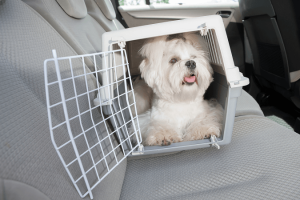How to travel with a dog?
If you plan to take your dog for a trip you most probably have milions of questions queuing up in your head, waiting for the right answers. Similar ones may arise when you need to transport your dog from one country to another.
“Are there any law regulations I should know about? “,”Are they universal for all EU countries?” – we will cover that in the first part of the article.
After that our favourite pet bloggers Hazel from www.havedogcantravel.com and Sonja from http://montecristotravels.com/ give some valuable advice and share their experience of travelling with their dearest canine friends.
So!
First: stop worrying:)
Second: just read on!
EU Regulations you should know about
I will walk you through the EU regulations you need to know about, before taking a domestic animal abroad. This might feel like a difficult part to get right, but it’s not! 🙂 I will do my best to make it as clear as possible in the outline below.
- Your dog must have a microchip inserted (some countries accept a tattoo). Microchip must be compatible with standards ISO 11784 in order to determine the name and address of the owner of the dog, using the reader ISO 11785 compliant. Since 2012 animals are marked by the implantation of a transponder, which is an identifying device that uses Radio Frequency Identification technology.
Why ISO standards are so important? When the chip meets ISO standards it can be read by any train, ferry or airline company in the EU country. If it doesn’t meet this criterion, you may need to take your own reader – otherwise your dog can be refused entry. - Your dog must be vaccinated against rabies.
The vaccination is valid after 21 days, counting from the day when the primary vaccination was given to the dog which is 3 months old (or above). Subsequent vaccinations, performed regularly, every year become valid on the same day when the vaccination is done. It is important to know that the date of administration of the vaccine cannot precede the date of inserting a microchip. - Your dog must have a passport with the details of the authorised vaccination against rabies and tapewarm, issued by an official veterinarian.
Having a pet passport updated is crucial when travelling because all the treatments and tests your dog had are supposed to be listed there. Check if your vet issues pet passports, and if not, ask for the nearest who does.
Important:
#Dogs need to be protected against tapeworm (Echinococcus multilocularis) before entering the territory of country of your destination, BUT: Dogs moving directly between Finland, Ireland, Malta or the United Kingdom are exempted from the treatment against the tapeworm Echinococcus multilocularis.
#Majority of EU countries does not permit to bring dogs under 3 months old
For any special cases not mentioned in the article please see the “Exeptions” section here.
I asked Sonja about her positive and negative experiences while travelling within and outside the EU countries and this is what she shared:
According to one of the transport providers, there might be some unnecessary complications when crossing the EU boarder through Eurotunnel. During the microchip check – if problems occur – transport provider is obliged to leave a dog until one returns to its home country. Therefore it might be best to make sure that we possess all the necessary documents before the procedure begins!
Your four-legged friend in a car
It doesn’t matter whether you want to travel with your hound by car yourself or you prefer to hire transport company to move your pet for you, shortly before or after you arrive to the destinated country – some general tips on transporting dogs will apply:
# Remember that your pet has to be transported in a car with ventilation system and access to food and water.
# Please, make sure that in case of sharp braking or an accident your dog remains still, in a safe place.
# To be even more careful you can strap the crate with seatbelts. If you are not a big fun of crate, you can think of using special seatbelts that will protect your dog during the ride.

Big dogs:
Big and average size dog should have their own space in a car. They can travel on a backseat – but rememeber – if you decide to make this space available for them, cover it with a thick blanket or other durable material.
Surely, it would not be easy for a large dog to sit still in a crate or a travel bag. Instead , you can prepare comfortable place for your dog in a boot of a estate car.
Small dogs:
# If your dog is rather small it is best to keep it in a crate (you can install the water feeder in a crate) or in a travel bag (see Zuki’s travel bag below)
# If you are transporting a puppy you can use a crate, a box or put it on a seat (covered by absorbent pad) next to the driver.
Not a fun of crates and boxes? Read on!
Sonja & Montecristo
Here is what little Montecristo (Sonja’s dog) recommended in the blog post:
To know more go to Sonja’s blog post.

Source: http://montecristotravels.com/
Then, I asked Sonja for advice on what to consider before taking a dog for a road trip:
Hazel & Zuki
Hazel Winstanley is a great role model for all the people who hesitate to travel with their dogs. As long as we educate ourselves as to how we can provide safe and comfortable travel for our pets, taking them abroad is absolutely possible!
Zuki is over 2 years old now – see how Hazel and Zuki have been travelling together and get some valuable tips on travel equipment 🙂



Pet transport company is an option
You may also prefer to let the professionals transport your dog for you. Many transport providers specialise in pet transport, therefore you can be sure they got into grips with methods of transport and equipment needed to move your dog safely. Below you can find sample transport jobs completed on Clicktrans
Dog transport from Almeria(SPN) to Barcelona(SPN)
Dog transport form Lodz(PL) to Edinburgh(UK)
Dog transport from Lodz(PL) to Scunthorpe(UK)
Average cost
The average transport cost within the EU countries varies between 210-320 £. Dog transport cost depends on how big is your pet, type of vehicle it will be transported in. You may hire a pet transport company or choose a transport provider who’s going towards the same destination as your pet anyway, and will be able to take it on the fly.
I hope that now you feel more confident about travelling with your dog. There is nothing more to do – just try!
Source : Source














planning to go to Romania via van/car, France, Belgium Czech or Austria, Hungary to Romania. I have seven dogs traveling with the two of us (Rottweiler, and 4 Mastiff crosses aged between 3 and 11) got passports and jabs in place….. Question other than car safety and passports are going to have any issues we are unaware of please?
@Wilf – it would be best if you check with customs for each of the countries you wish to travel, just to be sure. But the most important things to remember are vaccinations and the passport (and the microchip, of course!).